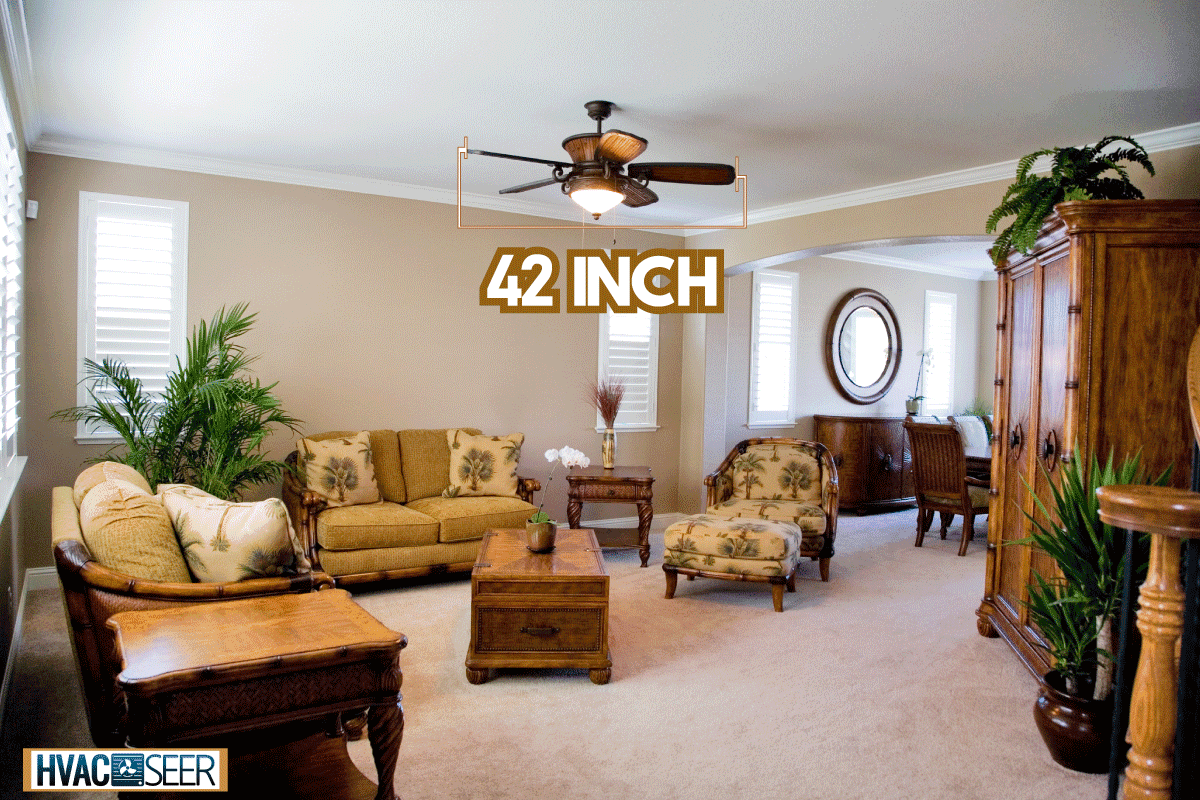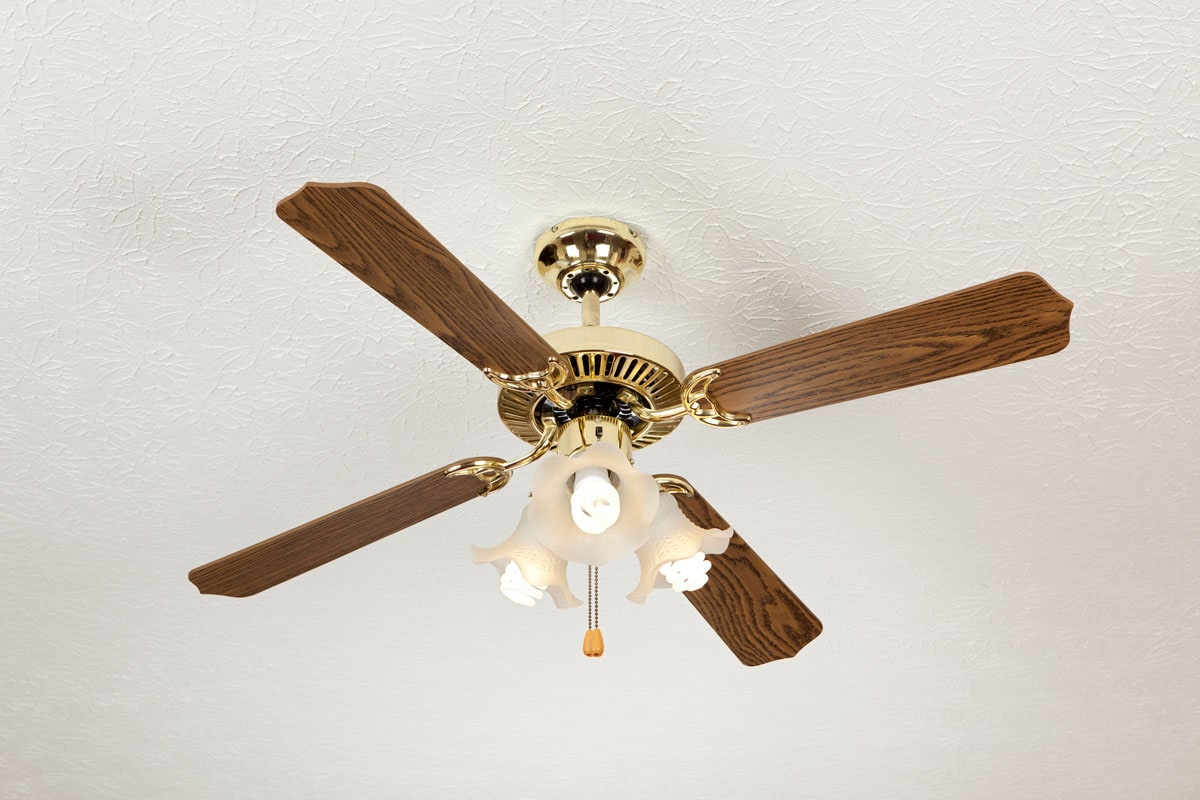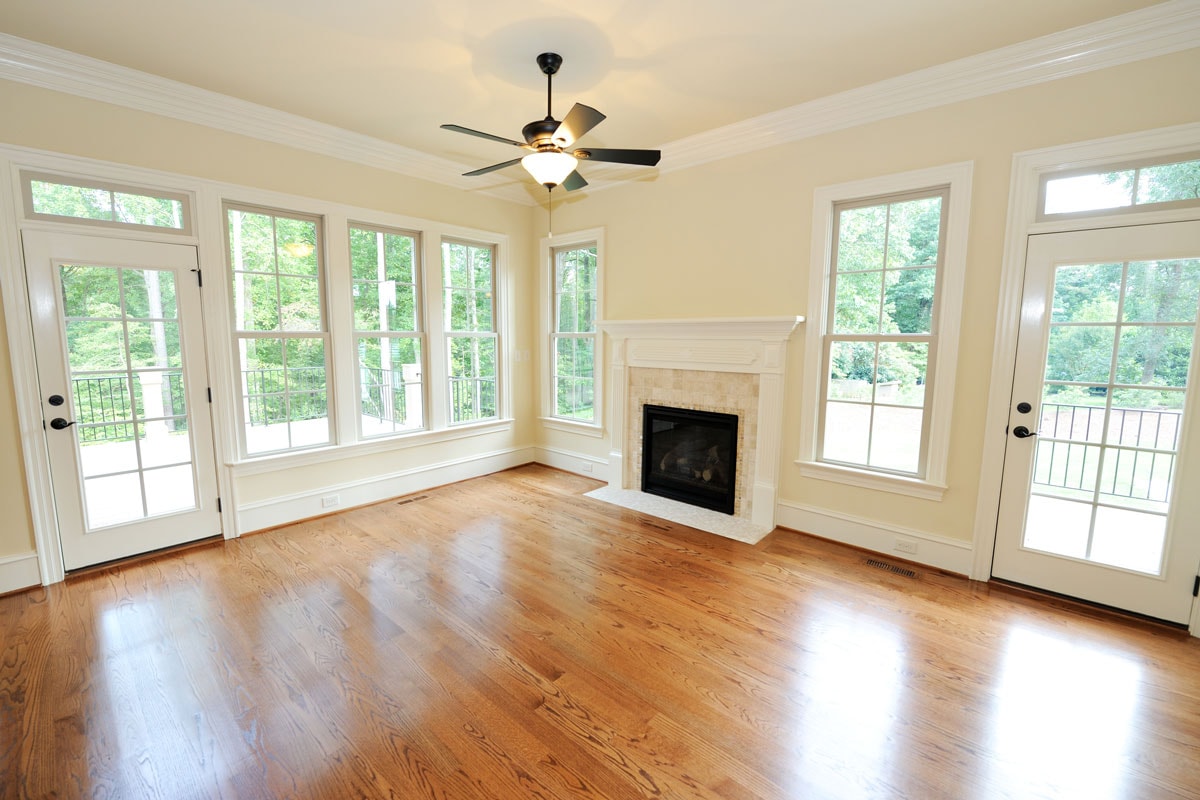The dimension of the room is technically the basis of the size of a ceiling fan. This just goes to show that the bigger the room is, the longer the blades of your fan should be. In this post, we'll guide you through the right ceiling fan sizes so you can have that homey atmosphere year-round with the family.
Considering the room type and layout, a 12 x 12 room (144 square feet) requires a 42-inch ceiling fan. This fan size is ideal for breakfast nooks, bathrooms, utility rooms, porches, and small bedrooms.
Alongside the size of the ceiling fan blades, you should consider the height of the fan from the floor. Moreover, look into the unit's CFM or the amount of air the fan can stir per minute. We'll elaborate on these aspects and more, so read on!

What Size Ceiling Fan For 12X12 Room?
Rooms serve a wide variety of functions and come in various sizes. A room with a 12 x 12 dimension is your typical medium-size bedroom that can fit even a king-size bed.
Additionally, with a habitable space of 144 square feet, this room needs a ceiling fan with 38 to 42-inch-long blades. Blades of this size can already ensure an adequate CFM rating of 2,000 to 4,000.
Ceiling fans with 38 to 42-inch-long blades are likewise ideal for living rooms and other spaces that have the same floor area or even less. Note, however, that you will need to install bigger ceiling fans in rooms with higher ceilings.
Check out this elegant 42-inch white ceiling fan on Amazon.
What Is A Good CFM For A Ceiling Fan
CFM (cubic feet per minute) ratings vary for ceiling fans designed for residential or industrial uses. A good CFM for a ceiling fan is that which adequately creates airflow within a space, either enclosed or outdoor.
That said, the higher the CFM rating, the more efficient your fan becomes, giving you a better air circulation and cooling effect.
To know whether or not a ceiling fan's CFM is good, airflow efficiency can be obtained by dividing CFM by the amount of energy (watts) used to run the fan at its highest speed.
Worry not. You need not bother yourself with the computation! This calculator can do the work.
Approximately 75 CFM/w is the minimum number to be considered efficient. Of course, larger rooms and outdoor spaces require higher CFM ratings.
There are fans that have good CFM ratings but consume very high wattages. To reduce your monthly energy cost, buy a ceiling fan that has a high CFM with low wattage.
How To Measure Ceiling Fan Size
Whether you're installing a new ceiling fan or replacing an old one, you should know the two ways of measuring the size of its blades. Fans can have odd or even number of blades.
Fans With Even Number Of Blades
Get a tape measure to get the distance between the tip of the blade to the tip of the opposite blade. Measuring from tip to tip means you're getting the diameter of the fan.
Fans With Odd Number Of Blades
Starting at the center of the fan, extend the measuring tape up to the tip of a blade to get the radius. Multiply the radius by two to determine the diameter.
Do Fewer Blades Mean Better Air Circulation?
Homeowners have a common notion that fans with more blades perform better in circulating air. This, however, isn't always true nowadays due to modern technology. In fact, there are fans (i.e., industrial fans) with two blades only, and still they create powerful airflow!
The elements that actually make fans work more efficiently are motor power, blade pitch, and balance of the blades--not solely the number of blades.
Although there is no perfect number of blades, we explored some advantages and disadvantages attributed to having 3, 4, or 5 blades in this article:
How Many Blades Are Best on a Ceiling Fan?
How Close Can Fan Be To A Wall And A Light Fixture?

After knowing the size of the blades, consider next the distance between the blades and the closest wall and a light fixture (aka luminaire). This is especially important when first installing a new fan.
A ceiling fan should be installed at least 18 to 24 inches from the closest walls and at a minimum 0f 39 inches from any light fixture.
How Do I Determine The Hanging Height Of The Fan?

For optimal performance, ceiling fans should be mounted 8 to 9 feet above the floor and at least an 8-inch clearance from the ceiling. Use a downrod if your ceiling is more than 9 feet high.
A downrod is an extension pipe that connects the motor housing of the fan and the mounting bracket or hardware on the ceiling. With a downroad, you can stabilize your fan and reduce the possibility of wobbling.
Determine the length of the downrod by subtracting 9 feet from the ceiling height in feet. For instance, if you have a 12-feet high ceiling, the size of the downrod should be 3 feet.
What Size Ceiling Fan For 5 Other Spaces
Since rooms vary in sizes and functionality, the size of a ceiling fan should likewise adjust so it can move an adequate volume of air.
1. Living Room
Ceiling fans with blade length of 42 to 48 inches can work efficiently in medium-sized living rooms. Moreover, blades of these sizes can provide efficient air flow in spaces from 75 to 175 square feet.
If you're installing a ceiling fan in a large living room, especially with a high ceiling, go for 60 inches or greater.
Remember, however, that as you go for a fan with a bigger blade span, you must ensure that the ceiling is sturdy enough to support its weight.
Wondering if your ceiling can bear the weight of your fan? Read more about it in our article:
How Much Does a Ceiling Fan Weigh?
Check out this 60-inch wood ceiling fan on Amazon.
2. Bathroom
For a small bathroom, choose a ceiling fan with a blade diameter of less than 29 inches. A large bathroom, on the other hand, will need a 52 to 56-inch blade span.
Check out this 29-inch bathroom ceiling fan on Amazon.
3. Kitchen
Kitchens and dining room with 144 to 225 square feet area typically requires ceiling fans with 44 to 50-inch blade span. A 30-inch fan is just perfect for a smaller kitchen.
Check out this kitchen fan with dimmable light on Amazon.
4. Outdoor Living Space
You'll need bigger ceiling fans outdoors (e.g., porches and patios) because mostly these areas are not enclosed with walls. Furthermore, determining the size requirement of an outdoor ceiling fan can be confusing as the air flow tends to spread out.
An outdoor area of 100 square feet or less will require a 52-inch blade span. Whereas, an area of more than 100 square feet will need a 60-inch fan.
For a bigger patio or porch of more than 225 square feet, consider installing a 72-inch ceiling fan. We recommend installing two or more ceiling fans for areas of more than 625 square feet.
Here are some 52-inch outdoor ceiling fans you can check out on Amazon.
Hunter Cassius Ceiling Fan
Click here to see this fan on Amazon.
 Honeywell Ceiling Fan
Honeywell Ceiling Fan
Click here to see this fan on Amazon.
Outdoor space is always susceptible to nature's elements such as moist, snow, or rain. Be sure to get damp or wet-rated ceiling fans so they can withstand different environmental conditions.
Damp location-approved ceiling fans are protected against moisture that comes with outdoor air. On the other hand, wet-rated fans have sealed or protected electrical components. These fans were designed for places where water contact is often or unavoidable.
5. Office Space

Installing a ceiling fan in an office, for some people, may not be a bright idea. Its wind can possibly blow important documents off the table--and that can be annoying!
So, if you're planning to mount a ceiling fan at your office, determine first the area of your space. If you have an area of 75 square feet or less, buy a 36-inch fan. And if you have an area of up to 100 square feet, consider a 42-inch fan.
In Closing

A 12x12 room can be your bedroom, study area, office, etc. and this floor area requires a specific right-sized ceiling fan.
Your desired or expected indoor and outdoor cooling experience largely depends on your knowledge of the dimension of the room and the distance of your fan from the walls, floor, and ceiling.
As always, do not hesitate to consult HVAC professionals who know what's perfect and cost-effective for your home!
Did you find this post helpful? See other informative ceiling fan-related articles here:






